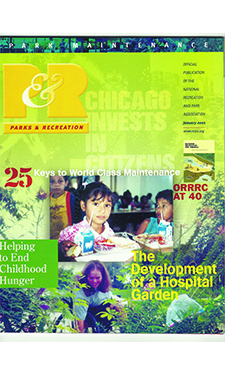 The parallels between Parks & Recreation magazine’s January 2002 and October 2015 issues are striking. Both include focused pieces on Chicago, childhood hunger and urban gardening. Both also make mention of the Windy City’s mayor of the era — the famous Richard Daley, in his address to the Great Parks, Great Cities Conference of 2001, and the equally well-known Rahm Emanuel in 2015, with his Chicago Plays! program. The details of all these subjects have certainly changed, but the essential cores of the stories remain largely the same. Chicago remains a storied city with incredible parks, the United States still struggles to adequately address childhood hunger and urban gardening continues its slow, but steady, increase in popularity.
The parallels between Parks & Recreation magazine’s January 2002 and October 2015 issues are striking. Both include focused pieces on Chicago, childhood hunger and urban gardening. Both also make mention of the Windy City’s mayor of the era — the famous Richard Daley, in his address to the Great Parks, Great Cities Conference of 2001, and the equally well-known Rahm Emanuel in 2015, with his Chicago Plays! program. The details of all these subjects have certainly changed, but the essential cores of the stories remain largely the same. Chicago remains a storied city with incredible parks, the United States still struggles to adequately address childhood hunger and urban gardening continues its slow, but steady, increase in popularity.
When Daley addressed his crowd 14 years ago, Millennium Park was still under construction. Maggie Daley Park, named for the former mayor’s beloved wife, wasn’t even a twinkle in the Chicago Park District’s (CPD) eye. And yet, numerous citywide beautification projects were underway, with some eventually finding their way into the city’s codified ordinances. “Come to Chicago and you’ll see flowers and shrubs in the street medians, not just downtown, but in the neighborhoods as well,” Daley said. “This is a result of our Landscape Ordinance, which requires developers…to install and maintain landscaping around their property and on the public way.” The law remains in effect today. Daley also took time to boast of the renovation of dozens of fountains and the planting of more than 300,000 trees during his term to date at that time (1989–2001 — Daley would remain Chicago’s mayor until 2011, when Emanuel would succeed him), among many other park and recreation-related achievements.
Daley’s emphasis on beefing up the beauty, usability and items of interest in his city proved incredibly prescient. “This is quite a wide variety of amenities…but they all have this in common: they improve the quality of life,” he said. “And I believe very strongly that the cities that pay attention — really pay attention — to quality of life will be the cities that thrive in the 21st century.” Chicago’s recently released economic impact study puts provable data to Daley’s assertions — Chicago Parks District’s diverse assets, and specifically its largest magnet properties (Soldier Field, Grant Park and museums) brought in an estimated $1.2 to $1.4 billion in economic activity in 2013. If that’s not indicative of a thriving city, this writer isn’t sure what is.
The same educational fervor that in 2001 underscored Maggie Daley’s After School Matters programming, which offered courses in the arts, technology and sports to thousands of young Chicagoans, supports initiatives like today’s underwater video display connecting kids at summer camp on Northerly Island to the nearby Shedd Aquarium. “Education has to take place at all hours, and on weekends and during the summer — and that means enlisting the help of libraries, parks and museums,” Mayor Daley said.
The parallels continue as Daley recounts the Calumet Open Space Reserve project, which in his day revitalized 4,000 acres of prairies, wetlands and forests on Chicago’s far southeast side — the recent completion of Northerly Island Park continues this tradition of thoughtful environmental stewardship for the benefit of all Chicago residents and visitors.
“If you offer the quality of life people desire, they will want to live in your city. It’s as simple as that,” Daley said. Some 14 years later, Chicago is still proving the veracity of that statement, even as its municipal peers scramble to follow suit.
Samantha Bartram is the Executive Editor of Parks & Recreation magazine.

